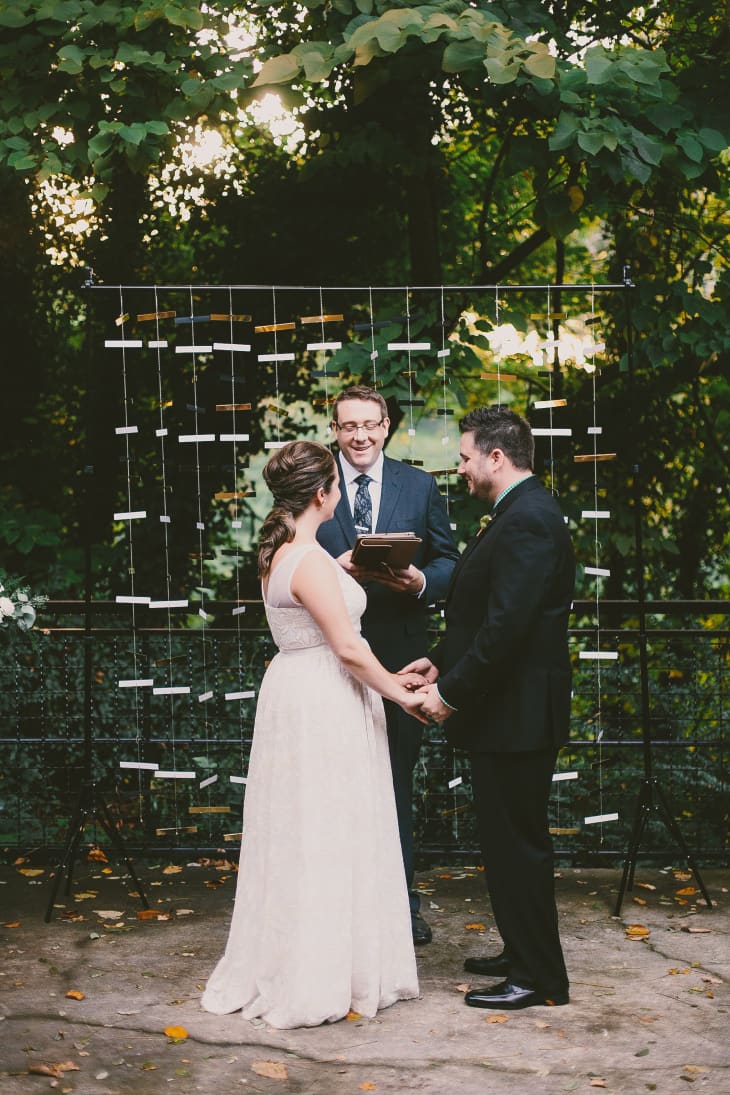How to Write Your Own Wedding Ceremony

The best weddings are the truly personal ones. And while there are a million and one ways to put your unique stamp on the day, there’s nothing quite as important–in a really kind of big, existential sense–as the words you hear, speak and share during your wedding ceremony. And I’m not just talking about the vows–you can script the whole show from beginning to end if you want to.
If you have the opportunity, time and willingness to get elbow deep in an ocean of words, writing your own wedding ceremony might be the most rewarding DIY project you take on for the big day. Writing the ceremony for our wedding gave my husband and me a chance to inject our own meaning into the promises we made that day. We were able to share our personal shared belief that there were no magic powers in exchanging vows, and that we weren’t fated together, instead making a conscious choice to be with each other. (We even wrote a bit in there about how important the sanctuary of home is to us–very Apartment Therapy, I think.)
You may agree with our sentiment, or not. What’s important is that you, as a couple, use your ceremony as an opportunity to commit to your own version of what you think a marriage should be about. Here’s how to make it happen:
Learn the Parts of a Wedding Ceremony
There’s an established cadence and structure that makes a wedding ceremony a wedding ceremony. You can, of course, play around with it as little or as much as you’d like, but like any great artist you should know the rules before you break them. The only thing you really need to have is the question of intent (the “I do” part) to make it legally binding.
There are plenty of resources online that will detail the parts of a wedding ceremony, each may be a little different than the rest. But here’s a rough outline I got from our wedding officiant Get Wed by Ed for a traditional Western ceremony:
- The Processional: Where everybody walks down the aisle.
- Greeting, Opening Words, and Welcome: Can be as short as a simple “thank you,” or introduce some background, like how the bride and groom became a couple.
- Declaration of Consent (Giving the Bride Away)
- Statement or Question of Intent (The I Do’s)
- Exchange of Wedding Vows
- Exchange of Wedding Rings
- Pronouncement, Declaration of Marriage and The Kiss
- Introduction and Presentation of the Newlywed Couple
- The Recessional
Decide What Kind of Ceremony You Want
More accurately, decide what you don’t want. Ask yourself some questions about traditions, rituals and logistics:
- How long do you want the ceremony to be?
- Should the ceremony feel more formal or casual?
- What religious traditions, if any, do you want to incorporate?
- Do you want to incorporate any other rituals like a unity candle, handfasting or sand ceremony?
- Will you have readings or other stories incorporated into the ceremony?
- Do you want your guests to participate or just spectate?
Knowing the answers to these questions will help guide the rest of the decisions you make about the ceremony.
Collect Ceremonies that Speak to You
Now’s the time to seek out examples of wedding ceremony text, both online and from the officiant performing your ceremony. Seek out ceremonies that vibe with your beliefs, whatever they may be. Then copy and paste the parts that sound good to you into a document somewhere on your computer, on your phone or on the cloud. You’ll want to save any full quotes or readings you like, but also simple turns of phrase or even single words that capture the mood you’re going for. “In word and deed.” Paste. “There is little to say you haven’t already heard.” Paste.
The goal is just to gather those notes together, whether they’re romantic or traditional or just funny (if that’s your style). One of my favorite notes in my wedding ceremony document was this:
The best line I’ve ever heard an officiant say is “If anyone has any objections to why these two should not be married, now is not the time. You had years leading up to this point, but please find me after the wedding because I love gossip.”
We didn’t end up using it, but I still giggle when I think about it.
Piece it All Together
At some point down the road, a few months before the wedding, you’ll need to merge your Frankenstein document into a real ceremony. Start a second document with headings corresponding to the parts of the ceremony (from above), and start pasting your pieces in place. You’ll start to edit everything down, merging the parts that share the same sentiments and leaving out any redundant bits. This is the time to add your own original writing, too. Capture your own thoughts and feelings about the promise you’re making, and ask your bride or groom to do the same. Read and re-read what you have a few times, editing it down as you go.
Polish it Off With an Officiant
This is where it all comes together. Your officiant will be an invaluable resource when it comes to whittling down all your ideas into a cohesive ceremony that makes sense, flows well, and (maybe most importantly) is just as long to read as you want your ceremony to last.
Did you write your ceremony? Have any tips to share?